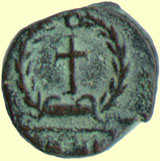 Contents -
Previous Article -
Next Article
Contents -
Previous Article -
Next Article
Visit the Gallery of Scarce and Unusual Later Types Table of Contents now
The twenty - four Roman mints struck coins numbering into the billions between the years of AD 294 - 500. Many of the earlier pieces were quite well struck and most types could be organized neatly into categories based on the reverse image or type. The artwork, if not exceptional, was at least reasonably competent. The great abundance of these small bronze coins that survive today and the diversity of their mintmarks and officina leters has produced a fertile field for the modern collector of these varieties.
During the early Fifth Century, however, the quality of the artwork and die engraving on the products of even the mints at Roma and Alexandria declined markedly. As the Fifth Century progressed, most of the bronze coins larger than the US Cent disappeared. The tendency was toward tiny, crude types the size of an aspirin tablet or a little larger. Even when newly struck, the poorly executed designs on these tiny bits of metal made them hard to identify in many cases. When pieces have survived, they have been found in worn and corroded condition. Occasionally a well struck and centered piece was struck from a better set of dies and was lost or hidden before it had circulated very much. If the conditions under which it was lost or hoarded were such as to preserve the piece from further corrosion or damage, it might survive intact to be discovered by a modern archaeologist or antiquities hunter. Because the odds of this chain of events actually coming to pass are exremely slim, these late pieces are rare in even mediocre condition despiet the fact that millions were struck.
Gallery of Scarce and Unusual Later Types Table of Contents
Identifying Common Fourth Century Roman Bronze Coins
Reading the Emperor's Name and Titles
A Picture Gallery of Fourth Century Reverse Types
Camp Gate
Altar Inscribed VOTIS XX
Two Soldiers Standing With Two Standards
Two Soldiers Holding One Standard
Wreath With Legend Inside
Soldier Spearing a Fallen Horseman
VRBS ROMA Commemorative - Mother Wolf Suckling Twins Romulus and Remus
CONSTANTINOPOLIS Commemorative - Victory Standing on Prow of Ship
Two Victories Each Holding a Small Wreath
Two Victories Each Holding a Large Wreath on Centenionals of Decentius
Emperor Holding Labarum or Standard and Dragging Captive
Emperor Raising Kneeling Captive
Victory Advancing Left
A Key to Fourth Century Inscriptions
Some Scarcer Late Fourth Century and early Fifth Century Types
All New! More image galleries of late Roman bronze types.
Camp Gate
Altar with Votis, Victories with Wreath
FEL TEMP REPARATIO, Soldier Spearing Fallen Horseman
More FEL TEMP, including Barbarian and Hut tupes
Victory Advancing Left Holding Wreath
Emperor Holding Labarum and Dragging Captive